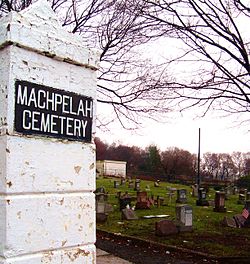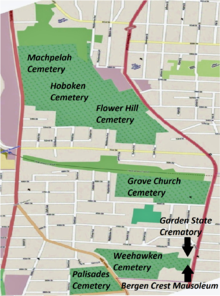
The Hudson–Bergen Light Rail (HBLR) is a light rail system in Hudson County, New Jersey, United States. Owned by New Jersey Transit (NJT) and operated by the 21st Century Rail Corporation, it connects the communities of Bayonne, Jersey City, Hoboken, Weehawken, Union City, at the city line with West New York, and North Bergen.

Flower Hill Cemetery is located in North Bergen, New Jersey. It is cojoined with Hoboken Cemetery and Machpelah Cemetery.

The Hoboken Cemetery is located at 5500 Tonnelle Avenue in North Bergen, New Jersey, United States. in the New Durham section. It was owned by the City of Hoboken. The Flower Hill Cemetery borders it on two sides. Although one may have the sense of a well groomed and cared for cemetery when first arriving at the Hoboken Cemetery, just a short walk in any direction and you will find a different story. It is bordered by Flower Hill Cemetery. The Secaucus Junction was built on land that was partially the Hudson County Burial Grounds. The exhumed bodies were to be re-interred at the Hoboken Cemetery but that was cancelled when the cemetery was found to have been recycling older full graves that did not have tombstones, and selling them as virgin plots. The cemetery said it has no record of any bodies being buried in those plots.
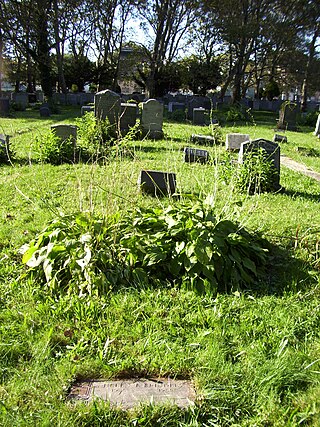
Bayview Cemetery, previously called Greenville Cemetery, is located in Jersey City, New Jersey. It merged with New York Bay Cemetery and is now known as Bayview – New York Bay Cemetery.

SS Saale was an ocean liner for North German Lloyd in the late 19th century, which was severely damaged in the 1900 Hoboken Docks Fire. On 30 June 1900, Saale was moored at the North German Lloyd piers in Hoboken, New Jersey, preparing to depart on a transatlantic crossing when some cotton on a nearby pier caught on fire and spread to the ship. Saale and several other ships were soon engulfed in flames; 99 passengers and crew on Saale were killed in the fire and subsequent sinking.

The Hackensack Plank Road, also known as Bergen Turnpike, was a major artery which connected the cities of Hoboken and Hackensack, New Jersey. Like its cousin routes, the Newark Plank Road and Paterson Plank Road, it travelled over Bergen Hill and across the Hackensack Meadows from the Hudson River waterfront to the city for which it was named. It was originally built as a colonial turnpike road as Hackensack and Hoboken Turnpike. The route mostly still exists today, though some segments are now called the Bergen Turnpike. It was during the 19th century that plank roads were developed, often by private companies which charged a toll. As the name suggests, wooden boards were laid on a roadbed in order to prevent horse-drawn carriages and wagons from sinking into softer ground on the portions of the road that passed through wetlands. The company that built the road received its charter on November 30, 1802. The road followed the route road from Hackensack to Communipaw that was described in 1679 as a "fine broad wagon-road."
Pieter Van Buskirk, also spelled Boskerck, is considered the first settler in the Constable Hook area of Bayonne, New Jersey.
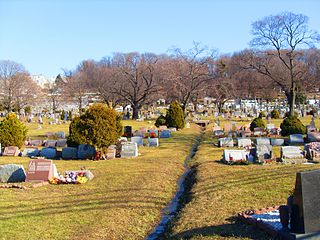
The Weehawken Cemetery, like neighboring Hoboken Cemetery, is not located in its namesake town of Weehawken but rather on the western slope of the Hudson Palisades in North Bergen, New Jersey, with its main entrance on Bergen Turnpike. At its east side the cemetery is overlooked by the Bergen Crest Mausoleum and the Garden State Crematory. and nearby Flower Hill Cemetery.

Schuetzen Park is a privately owned park in North Bergen, New Jersey, United States, that has existed since 1872 and is located on the ridge of the Hudson Palisades at Kennedy Boulevard and Bergen Turnpike just north of the Marginal Highway. Its southern and western perimeters are shared with the Fritz Reuter Altenheim, a retirement community named for the German author, Fritz Reuter, and Columbia Park, a large shopping center. The German-American Volksfest has taken place there annually since its construction.

New Durham is a neighborhood in North Bergen Township in Hudson County, in the U.S. state of New Jersey. It is located near the foot of Union Turnpike and Bergen Turnpike, and south of the Tonnelle Avenue Station of the Hudson Bergen Light Rail. It is one of the few residential areas along the otherwise industrial/commercial Tonnelle Ave, and site of one of the town's main post offices.

Bergenwood is a long narrow district of North Bergen, New Jersey in the northern central part of the township between Kennedy Boulevard and Tonnelle Avenue, characterized by the steep slopes on the west side of the Hudson Palisades as they descend to the New Jersey Meadowlands.
Machpelah Cemetery may refer to:

The Grove Church Cemetery is a nonsectarian cemetery, located on the western slope of the Hudson Palisades, along with several other cemeteries in a string of green open space, in Hudson County, New Jersey, United States. The Grove Church, who owns the cemetery, is one of the oldest religious bodies in the area, and it has had an operating cemetery since 1847. Throughout its history, prominent families have been buried there, as well as American Civil war veterans. There have also been reports of vandalism and misuse of the property since the 19th century, and in 2007 some of the cemetery grounds were occupied by the homeless.

Bergen Crest Mausoleum is a mausoleum in Hudson County, New Jersey.

The Abel I. Smith Burial Ground was a family burial plot in Hudson County, New Jersey, United States.

Maisland, or Mais Land, was an area in Hudson County, New Jersey.
Lorenzo Welton Elder, M.D. was an American physician and politician who served as the sixth mayor of Hoboken, New Jersey, from 1863 to 1864 during the American Civil War. It was through his efforts that the Hudson County Board of Health was established. He was president of the Hudson County Pathology Society and was deputy adjutant-general on the staff of Governor Rodman McCamley Price. He was the local medical examiner of the Mutual Benefit Life Insurance Company of Newark, New Jersey, and of the New York Life Insurance Company. He was three times elected as the tax commissioner for Hoboken.

The 1900 Hoboken Docks fire occurred on June 30, 1900, and killed at least 326 people in and around the Hoboken, New Jersey, piers of the Norddeutscher Lloyd (NDL) shipping company. The piers were in New York Harbor, at the foot of 3rd and 4th Streets in Hoboken, across the North River from Manhattan in New York City. The area, a few blocks north of Hoboken Terminal, is now mostly part of the Hudson River, without docks: a waterfront bicycle path lines it.
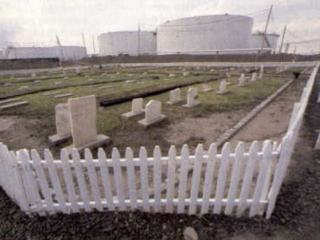
Constable Hook Cemetery is the name used to refer to two cemeteries on Constable Hook in Bayonne, New Jersey, the extant Bayonne Constable Hook Cemetery and the no longer existing Van Buskerck Family Burial Ground. Both were founded by members of the van Buskirk family, descendants of the cape's first settler, Pieter Van Buskirk. In 1906 the Standard Oil Company purchased the family land to expand their refinery, already the largest in the world at the time. Myths and historical inaccuracies have led to confusion about the two burial grounds.
